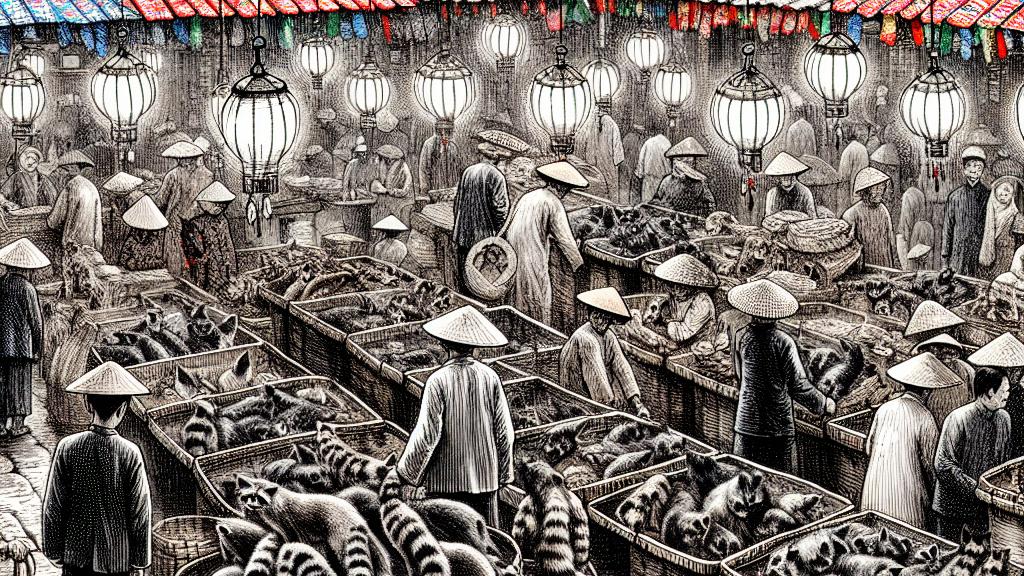Understanding the Animals Behind the COVID Pandemic
Overview
- The COVID-19 pandemic likely originated from animals sold at the Huanan Seafood Market in Wuhan, China, revealing critical zoonotic transmission pathways.
- Raccoon dogs, identified as primary suspects, have garnered substantial scientific interest, tracing genetic links to initial human cases.
- Extensive ongoing research supports the theory of a natural outbreak, diminishing the plausibility of laboratory-based explanations.

The Market Connection
At the heart of the COVID-19 pandemic's origins lies the Huanan Seafood Market in Wuhan, China. Imagine a bustling market filled with an eclectic mix of live animals, colorful stalls, and people milling about, unaware of the potential dangers lurking within. It was here, in late 2019, where environmental samplings began to paint a stark picture of how the virus could have first emerged. Research has shown that genetic material collected from various animals, particularly raccoon dogs, matched closely with samples taken from initial human cases. This crucial connection reveals not just a location but also the dynamics of how zoonotic diseases can leap from animals to humans in such interactions—a vivid reminder of the risks inherent in wildlife markets.
Who is the Raccoon Dog?
Raccoon dogs, scientifically known as Nyctereutes procyonoides, are intriguing creatures, often regarded as animal kingdom oddities due to their unique appearance and behavior. With a striking resemblance to both raccoons and domestic dogs, these animals are often hunted for their fur and sometimes consumed as food. However, what truly places them in the spotlight of the pandemic is their concerning ability to harbor and transmit SARS-CoV-2 without displaying symptoms. For example, studies have demonstrated that raccoon dogs, readily available in the Huanan market, could easily pass the virus to other species due to their viral load. This highlights a crucial factor: the entwined fate of wildlife and human health. The very traits that make these animals enchanting could also pose significant risks to public health.
Evidence Over Speculation
As discussions around the origins of COVID-19 have unfolded, it has become increasingly clear that the narrative of a lab leak is losing ground. Instead, a robust body of scientific evidence points towards a natural zoonotic origin. Researchers have meticulously analyzed hundreds of environmental samples from the Huanan market, revealing that the virus's genetic sequences closely align with those found in raccoon dogs. For instance, specific swabs from market stalls contained both the virus and animal DNA, showcasing an intricate web of potential transmission. Such findings not only dispel myths surrounding laboratory origins but also emphasize the need for urgent action regarding wildlife trade practices. This convergence of genetic evidence reinforces the idea that our interactions with wildlife deserve serious scrutiny to prevent future pandemics.
Looking Ahead
As we forge ahead in understanding the COVID-19 pandemic's origins, several lessons demand our attention. The connection to wildlife markets, especially concerning raccoon dogs, highlights a crucial opportunity to reassess public health strategies. Regulators must prioritize stricter controls on wildlife trade, better sanitation practices, and increased surveillance of animal populations. Simultaneously, public awareness about the dangers associated with these markets is essential. Moreover, preserving natural habitats and implementing more robust animal welfare policies can greatly mitigate the risk of zoonotic diseases. This is not just an academic concern; it has far-reaching implications for global health. By embracing these insights, we can enhance our resilience against future outbreaks, ultimately safeguarding both human and environmental health for generations to come.

Loading...